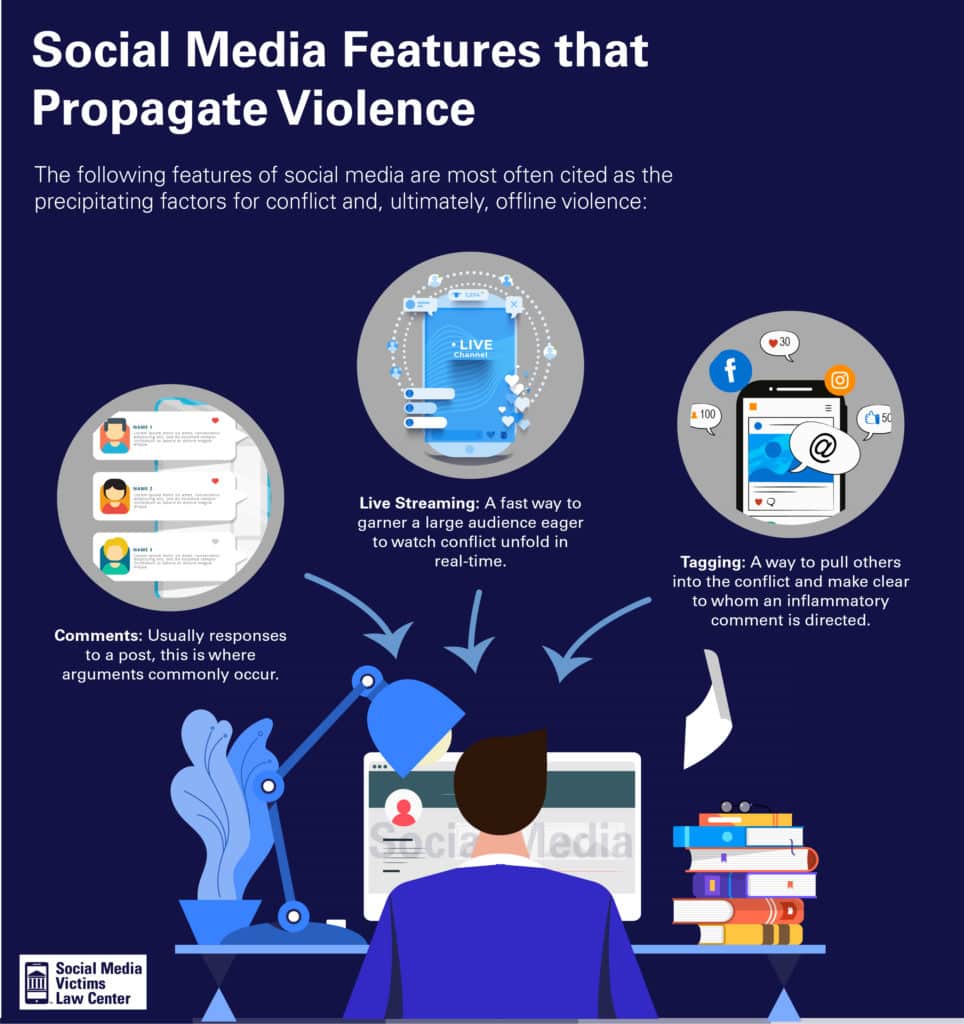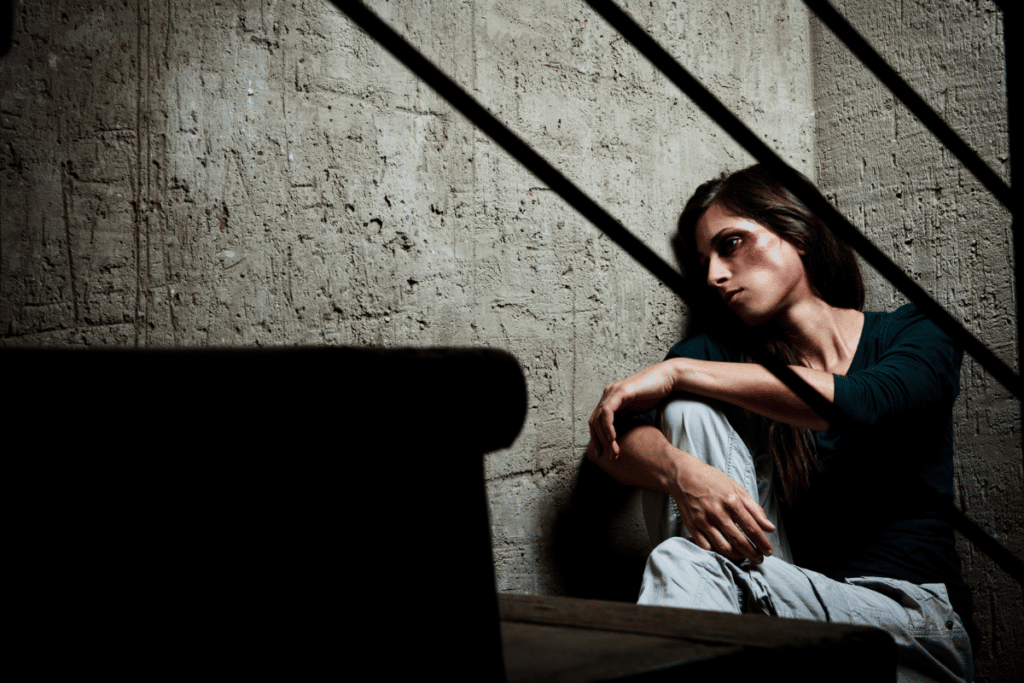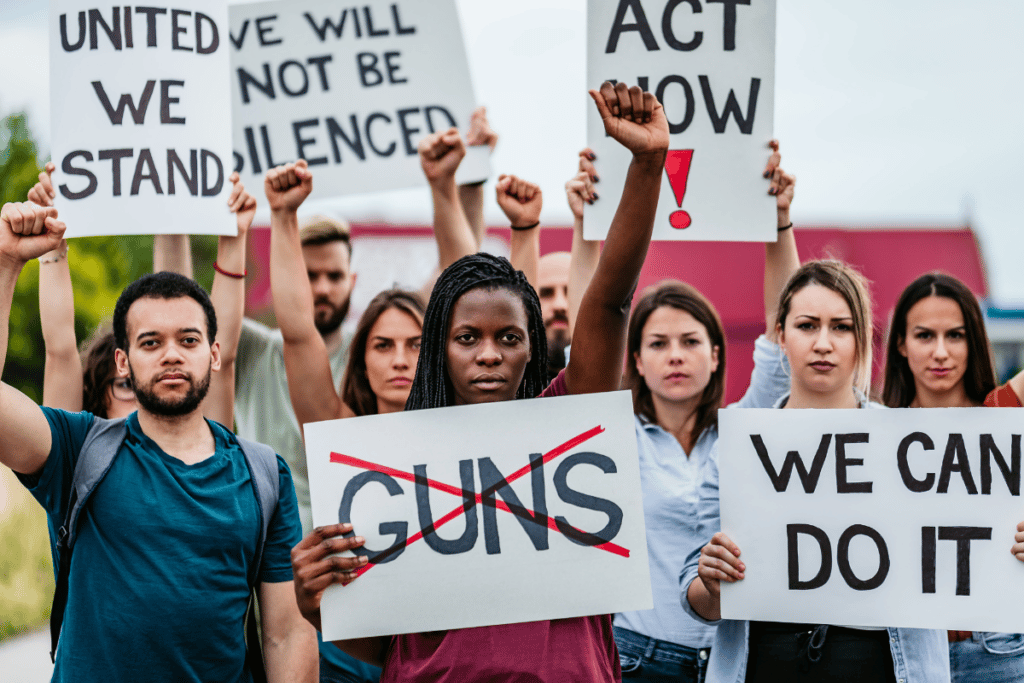Social Media Violence
Social media sites allow individual users to build global networks. The concept behind social media seems harmless. It offers young people opportunities to stay connected with friends and family while meeting new friends, even from other cultures. It also provides a forum to share accomplishments, ideas, and information.
 Written and edited by our team of expert legal content writers and reviewed and approved by Attorney Matthew Bergman
Written and edited by our team of expert legal content writers and reviewed and approved by Attorney Matthew Bergman
- Content last updated on:
- October 2, 2025
Written and edited by our team of expert legal content writers and reviewed and approved by

- Content last updated on:
- October 2, 2025
What You’ll Learn
- Profits Over Safety
- How Violence in Media Promotes More Violence
- The Online Disinhibition Effect
- Expanded Audience for Personal Conflicts
- Social Media Features that Propagate Violence
- How Street Gangs Use Social Media to Spread Violence
- Targeted Violence
- How does social media affect domestic violence?
- Human Trafficking
- Domestic Terrorism
- School Shootings
- Tips to Prevent Real-Life Violence from Social Media Interactions
- What to Do if You Experience Violence Because of Social Media
The concept behind social media seems harmless. It offers young people opportunities to stay connected with friends and family while meeting new friends, even from other cultures. It also provides a forum to share accomplishments, ideas, and information.
Despite these potential benefits, social media has a dark side. Social media has been used to both plan and display acts of violence. Social media violence statistics correspond increasingly to mass shootings in the United States and large-scale violence throughout the world.
For example:
- Russia used Twitter to provoke the slaughter of the White Helmets, a major humanitarian group in Syria.
- The military in Myanmar used Facebook to launch a genocide.
- Radical groups like ISIS have long used social media to spread extremist views, recruit members, target victims, publish manifestos, and coordinate attacks.
Even individuals who don’t plan to use social media for violent purposes find themselves caught up in violence. That’s because most platforms profit primarily from advertising revenue, so increased user activity equals higher profits. Therefore, social media platforms use algorithms that take advantage of the most vulnerable aspects of human nature to attract users and keep them on their platforms for as long as possible.
According to Facebook whistleblower Frances Haugen, social media platforms determine what content to display on a user’s newsfeed based on the type of content the user has liked, shared, or commented on in the past. Violent, inciting, and anger-provoking content performs well on these metrics, resulting in violent content being displayed more often than benign content.
Repeated exposure to violence in media is widely known to have a desensitizing effect on children and youth. The dynamics of interacting on social media can lead users to express themselves in ways they wouldn’t consider in offline interactions. Some will behave in an out-of-character, openly hostile manner while others may overshare.
This is known as the online disinhibition effect, where inhibitions are lowered because online interactions offer anonymity, invisibility, and feelings of reduced accountability. This can lead to cyberbullying and intense arguments that end in violent face-to-face confrontations.
Minorities and other marginalized groups experience the highest degree of social media violence, much of which results in real-life consequences.
Women and teenage girls fall prey to numerous forms of online sexual violence on a daily basis, including cyberstalking, threats, videos depicting rape, and the distribution of sexual images without consent.
Women of color who work in publicly visible positions experience more online sexual harassment than their white counterparts and social media platforms have done little to protect them, even when issues are reported.
Members of the LGBTQ+ community receive more social media abuse than any other group, with as many as 64 percent of their online community experiencing hate speech and harassment on social media.
In 2019, a professor from the University of Oklahoma posted a series of videos on TikTok detailing his analyses of white supremacy and systemic injustice. He was immediately flooded with hateful racist comments. The professor has received death threats, his wife has been harassed online, and even his children’s names have been brought up in online threats.
The Black Lives Matter co-founder and other Black women have experienced similar abuse. A study from Amnesty International and Element AI that measured violence against women on Twitter showed that “Black women were disproportionately targeted, being 84% more likely than white women to be mentioned in abusive or problematic tweets.”
Despite claims by social media platforms that they don’t tolerate racism, their algorithms reveal the opposite. The purveyors of violence find social media an easy outlet to find like-minded individuals and constantly harass their victims.
Social media provides an additional weapon for domestic abusers to publicly humiliate their victims through tactics such as revenge pornography, disparaging public comments, cyberstalking, harassinment, and exploiting them through sex trafficking. This can damage a victim’s reputation and impair their ability to obtain or keep employment.
Human trafficking – the exploitation of human beings for labor or sexual purposes – frequently begins on social media websites because that’s where children, teens, and young adults can be found.. Over half of all online recruiting occurs through Facebook. Facebook is aware of its role but has yet to take meaningful action.
Prior to internet technology, white supremacists and other extremists were on the fringes of society. The popularity and ease of using social media have made it easy for extremists to find each other and build networks.
School shootings are on the rise, and social media violence corresponds with the increased coverage and video footage these shootings receive on social media networks. Sensationalizing school shootings in this manner can inspire copycats and spur more incidents. The desensitization to violence and lack of empathy that results from repeated exposure to this type of footage could fuel more of these shootings.
Social media platforms endanger the public with their pro-violence, discriminatory algorithms, which prioritize profits over public safety. If you or your child has been threatened, harassed, or physically attacked in a social media interaction, The Social Media Victims Law Center can help you hold these companies accountable. Contact us today to schedule a free consultation.
Despite its potential benefits, social media has a dark side. Social media is used to both plan and display acts of violence. Social media violence statistics correspond increasingly to mass shootings in the United States and large-scale violence throughout the world.
For example:
- Russia used Twitter to provoke the slaughter of the White Helmets, a major humanitarian group in Syria.
- The military in Myanmar used Facebook to launch a genocide.
- Radical groups like ISIS have long used social media to spread extremist views, recruit members, target victims, publish manifestos, and coordinate attacks.
Even individuals who do not intend to use social media for violent purposes find themselves caught up in violence due in large part to algorithms that promote violent content and encourage activities that lead to real-life violence.
Profits Over Safety
How Violence in Media Promotes More Violence
Repeated exposure to violence in media is widely known to have a desensitizing effect on children and youth. As the sight of violence becomes normalized, it becomes less upsetting, and a lack of empathy can develop.
A 30-year study by the University of Michigan revealed a 40 percent decline in empathy among American college students, with the most marked decline occurring after social media became popular. Lack of empathy increases violence through the following mechanisms:
- Increased cruelty
- Decreased concern about the feelings of others
- Increased propensity to bully
- Decreased likelihood of helping others
The Online Disinhibition Effect
The dynamics of interacting on social media can lead users to express themselves in ways they would not consider in offline interactions. Some users will behave in an openly hostile manner that is out of character for their offline personas, while others may overshare.
This is known as the online disinhibition effect, where inhibitions are lowered due to anonymity, invisibility, and feelings of reduced accountability in online interactions. This can lead to cyberbullying and intense arguments that end in violent face-to-face confrontations.
Expanded Audience for Personal Conflicts
Social validation and a sense of belonging are important goals for teens, who often turn to social media in pursuit of these goals. While some teens limit their networks to people they know, others develop large networks with hundreds or even thousands of followers.
What is considered a threat on social media?
Each action, no matter how small, can have strong meaning and consequences in networks involving young people, who are hyperaware of social cues. Whereas in real life, a breach of etiquette may be forgivable, on social media, even the smallest slights that would be of no consequence offline, can quickly escalate.
As Professor Lance Williams of Northeastern University told NBC 5 in Chicago, social media “puts conflict on steroids.”
Fights
When heated social media arguments occur in front of large audiences, followers often egg them on or participate. Whether the audience sides with one party or is equally divided, both parties may feel pressured to save face by refusing to concede or reconcile.
If one party challenges the other to a real-life fight, pressure to follow through may feel insurmountable. Spectators and social media friends or followers may show up with their phones so they can record it, livestream it, or join in. Both parties may experience taunts from their peers until the fight occurs.
Cyberbullying
Cyberbullying is itself a form of violence that involves using social media to harass, threaten, intimidate, or humiliate a victim. The presence of a large audience provides a stage for cyberbullies to accomplish this.
For many teens, cyberbullying is far more cruel and damaging than in-person bullying. Social media content can quickly become viral, and once it is shared, it cannot be taken back and will only continue to spread. And because there are so many types of cyberbullying, it can be simultaneously subtle and pervasive.
Social Media Features that Propagate Violence
The following features of social media are most often cited as the precipitating factors for conflict and, ultimately, offline violence:
- Comments: Usually responses to a post, this is where arguments commonly occur
- Live Streaming: A fast way to garner a large audience eager to watch conflict unfold in real-time
- Tagging: A way to pull others into the conflict and make clear to whom an inflammatory comment is directed

How Street Gangs Use Social Media to Spread Violence
Street gangs have taken to social media as a means of communication among themselves as well as between rival gangs.
Internet Banging
Internet banging occurs when gang members taunt members of rival gangs over social media. It is not uncommon for gangs to use social media to challenge other gangs or even visit rival gang neighborhoods and post pictures and videos to mock gang members and further escalate tensions.
In Chicago, 17-year-old Gahrika Barnes, a known gang member, tweeted over 27,000 times to her 2,700 followers about her plans to retaliate against rival gangs whose members had murdered her friends. She was murdered within hours of tweeting the address of her hangout.
Targeted Violence
Minorities and other marginalized groups experience the highest degree of social media violence, much of which results in real-life consequences.
Gender-Based Violence
Women and teenage girls fall prey to various forms of online sexual violence on a daily basis. This includes cyberstalking, threats, videos depicting rape, and the distribution of sexual images without consent. These forms of violence can transform into real-life violence and interfere with women’s ability to feel safe at work or in public.
Women of color who work in publicly-visible positions experience more online sexual harassment than their white counterparts. Social media platforms have done little to protect women, even when issues are reported.
When social media platforms allow the abuse of women and girls to be displayed and glorified, they promote rape culture and increase the risk of all young women experiencing sexual assault, whether or not they use social media.

Violence Against the LGBTQ+ Community
Members of the LGBTQ+ community receive more social media abuse than any other group, with as many as 64 percent of the online LGBTQ+ community experiencing hate speech and harassment on social media.
This type of speech violates the policies of most platforms, but these policies are rarely enforced. Facebook is the biggest offender, with 75 percent of its LGBTQ+ users experiencing abuse.
Hate speech and online abuse cause many LGBTQ+ victims to fear for their physical safety. They may withdraw both online and offline as a means to protect themselves. For young people, this is especially damaging and can increase the risk of mental health disorders and suicide.
Racism
On May 14, 2022, a white supremacist gunman opened fire at Tops Friendly Market in Buffalo, New York, killing 10 people and injuring three more prior to surrendering to police. He had become radicalized in a social media community of like-minded white supremacists and livestreamed the attack over social media until the transmission was stopped. He selected the location for its Black demographic.
This is not the first time social media activity by white supremacists led to offline violence.
- In 2012, Wade Michael Page murdered six people at a Sikh temple in Wisconsin after posting in an online hate forum.
- Dylann Roof radicalized himself online prior to murdering nine Black church attendees in South Carolina in 2015.
- Robert Bowers murdered 11 elderly worshipers in a Pennsylvania synagogue after participating in a social media site used by white supremacists in 2018.
White supremacist groups continue to thrive on virtually all social media platforms and promote racism in social media.
Racist Algorithms
Despite claims by social media platforms that they do not tolerate racism, their algorithms portray the opposite.
In 2019, a professor from the University of Oklahoma posted a series of videos on TikTok detailing his analyses of white supremacy and systemic injustice. He was immediately flooded with vitriolic comments by apparent racists who also vindictively reported his most popular video to TikTok for violating guidelines. Much to the professor’s surprise, TikTok removed his video.
A Black influencer’s experience with uploading civil rights videos confirmed the professor’s experience. The videos had titles such as “Black Lives Matter” and “Black Success.” The influencer received a pop-up warning indicating his titles violated TikTok’s terms of service. When he entered terms like “white supremacy” and “I am a Neo-Nazi,” he received no warnings.
The professor has since received death threats. His wife has been harassed online, and even his children’s names have been brought up in online threats. He has noticed similar activity across platforms.
The Black Lives Matter co-founder and other Black women have experienced similar abuse. A study from Amnesty International and Element AI that measured violence against women on Twitter showed that “Black women were disproportionately targeted, being 84% more likely than white women to be mentioned in abusive or problematic tweets.”

How does social media affect domestic violence?
Social media provides an additional weapon for domestic abusers to use against victims in the following ways:
- To publicly humiliate through tactics such as revenge pornography or disparaging comments
- To cyberstalk when the victim attempts to leave
- To exploit through sex trafficking
- To harass
An abusive intimate partner’s social media activity can damage a victim’s reputation and impair their ability to obtain or keep employment.
Human Trafficking
Human trafficking is the exploitation of human beings for labor or sexual purposes. Victims of trafficking are most often children, either boys or girls, but teens and young adults are also trafficked.
Trafficking frequently begins on social media websites because that is where children can be found. Over half of all online recruiting occurs through Facebook. Facebook is aware of its role but has yet to take meaningful action.
Trafficking begins with a grooming process, where the trafficker poses as someone else until enough trust has been established to persuade the child to meet in person, at which time the child is abducted and sold.
Domestic Terrorism
Prior to internet technology, white supremacists and other extremists were on the fringes of society, often alone in their views with no convenient methods of connecting with other like-minded individuals. The popularity and ease of using social media have made it easy for extremists to find each other and build networks.
This increases their strength through numbers and enables them to find validation for their viewpoints as well as a means to gain support, publicize their views, recruit vulnerable individuals, and coordinate acts of violence. Over time, these groups gain nationwide and global support, enabling them to issue calls to action. For example:
- The January 6, 2021 riot at the nation’s Capitol began on social media.
- Thirty-one members of a white supremacist group were arrested on June 11, 2022, while arriving at a pride event for conspiracy to riot, which had originated on Twitter.
- The deadly 2017 Charlottesville protest was planned by white nationalists using social media.

School Shootings
School shootings are on the rise, and social media violence correlates with the increased coverage and video footage these shootings receive on social media networks. School shootings prior to social media were covered extensively in the news, but social media provides opportunities for users to view live footage from the perspective of witnesses and victims.
Sensationalizing school shootings in this manner can inspire copycats and spur more incidents. Additionally, the desensitization to violence and lack of empathy that results from repeated exposure to this type of footage could fuel more of these shootings.
Tips to Prevent Real-Life Violence from Social Media Interactions
Managing social media conflict requires different skills from face-to-face conflict. The following tips can help your teen avoid escalation in a conflict:
Ignore Posts that Are Deliberately Inflammatory or Angering
For many people, simply refusing to engage with anyone who harasses or bullies them on social media is an effective strategy.
The Online Harassment 2017 report from the Pew Research Center noted, “Fully 61% of those who have experienced online harassment say they ignored their most recent incident, while 39% chose to take some sort of step in response.”
Your teen may also opt to block abusive users.
Don’t Respond to Comments When You Are Angry or Emotional
If you must respond, take the time to think about how it will come across first. Respond with empathy, and never agree to a fight. It may help to remember the saying “hurt people hurt people.” A bully’s abuse is usually a response to their own pain and has nothing to do with you.
Report Cyberbullying
StopBullying.gov encourages victims of and witnesses to cyberbullying to report the behavior to the social media platform or online service provider, law enforcement, or their school.
Witnesses should speak up in a kind but firm manner, asking the bully to stop and reminding them that the victim is a real person with feelings. Often, as soon as one person speaks out, others will follow.
Never share inflammatory or hurtful posts, even with good intentions. This gives the bully an audience and satisfaction. Send the person being bullied supportive messages and encourage them to talk to a trusted adult.
Victims of cyberbullying should not respond online. This will only give the bully more ammunition. Instead, keep screenshots or printed evidence of the bullying or harassing messages, and block the bully.
If you have reason to believe you are in physical danger because of social media communications, report this to a trusted adult. If the danger is severe, contact the local authorities.
Social media platforms that fail to provide safeguards are as irresponsible as a car manufacturer who fails to equip a vehicle with brakes. Their actions leave even the most careful users vulnerable.
What to Do if You Experience Violence Because of Social Media
If you or your child has been threatened, harassed, or physically attacked in a social media interaction, it is not your fault. Social media platforms endanger the public with their pro-violence, discriminatory algorithms, which prioritize profits over public safety.
The Social Media Victims Law Center can help you hold these companies accountable. Contact us today to schedule a free consultation.
Frequently Asked Questions
For individuals and children who have been
We only handle cases on a contingent fee basis. This means that we are paid a portion of any recovery obtained in the case and you do not owe us any attorneys’ fees if the lawsuit does not result in a recovery.
Every case is unique. Our attorneys will work with your family to evaluate your potential case and help you evaluate whether filing a lawsuit or other legal proceeding is in your family’s best interest. Generally speaking, the types of cases we handle involve serious mental health effects, including attempted or completed suicide, eating disorders, inpatient mental health treatment, or sexual trafficking/exploitation that was caused by or contributed to through addictive or problematic social media use by teens and young adults.
We are a law firm based near Seattle, WA comprised of lawyers who have spent their entire careers representing victims who have been harmed by dangerous products. We are also parents. Shocked and troubled by the recent revelations about the harm caused to teens and young adults by social media platforms, which powerful technology companies have designed to be highly addictive, Social Media Victims Law Center was launched specifically to help families and children who have suffered serious mental harm or exploitation through social media use to obtain justice.
Contact Us Today
